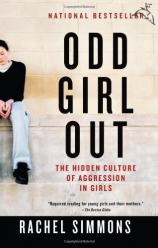Reading Group Guide
Discussion Questions
Odd Girl Out: The Hidden Culture of Aggression in Girls

1. More than once in the Introduction to Odd Girl Out, author Rachel Simmons refers to her book as a "journey." What kind(s) of journey-taking is she suggesting? And what sort of journey did you, as a reader, experience? Where did this book take you? Someplace new? Someplace familiar? Both? Explain.
2. Simmons bases much if not most of her data in Odd Girl Out on interviews and visits she conducted over a one-year period with girls from ten different American schools. As a class, identify, describe, and discuss these schools. Which school is most like your own-and how so? Which is least like your own-and why?
3. Near the beginning of Chapter Three, Simmons writes: "Girls don't have to bully [to] alienate and injure their peers...The word bullying couldn't be more wrong in describing what some girls do to hurt one another." Why does the author find this term inadequate? What other term(s) would you use instead? In addressing these queries as a class, reflect on both your own experiences and the idea of "alternate aggressions" (which is explored throughout this book).
4. Look again at the Ideal Girl/Anti-Girl chart that Simmons helps a group of girls at a leadership workshop compose in Chapter Four. As a class, create your own such chart, with everyone contributing traits and qualities for each of these two types. Then compare and contrast the chart your class made with the one appearing in Chapter Four. What lessons can you draw from looking at these two charts side-by-side?
5. In presenting a book that names, studies, and categorizes "the hidden culture of aggression in girls," Simmons often looks back on her own girlhood experiences to make a point, provide a detail, or give an example. Nowhere is this more evident than in Chapter Five ("The Bully in the Mirror"). Explore the memories Simmons shares with us about her friends Anne and Jenny. What regrets does she express concerning these relationships, and-despite these regrets, or maybe because of them-what wisdom does Simmons pass on to us? Where else in the book do we see the author uncovering truths that can be applied to all girls by revealing certain truths about her own girlhood?
6. As a class, discuss Chapter Six ("Popular"). In particular, consider the connections-both explicit and implicit-that might be made between popularity and deception.
7. Reread the section in Chapter Eight called "When Cultures Collide." Then, talk openly and candidly with your classmates about moments of alternative aggression that you have experienced with girls of an ethnicity or race different from your own. Do your experiences-or those of any of your classmates-reflect those of Jasmine? Ntozake? Tiffany? Jacqueline? Anyone else in Chapter Eight? How so?
8. In Chapter Nine, Simmons "offer[s] strategies to combat alternative aggression, including new directions for policy making and teaching. Most of the suggestions came directly from the parents, school officials, and survivors of bullying" Simmons met during her research. Reviewing these strategies as a class, point out which ones seem most realistic, helpful, and workable. Why do the strategies you have thus chosen seem viable? That is, what is it that makes these particular strategies seem convincing and effective to you?
9. In her Conclusion, Simmons writes: "Most of the behaviors mapped out in this book-nonverbal gesturing, ganging up, behind-the-back talking, rumor spreading, the Survivor-like exiling of cliques, note passing, the silent treatment, nice-in-private and mean-in-public friends-are fueled by the lack of face-to-face confrontations." As an independent project, write a short essay in which you describe a key moment in your life when you stood up to someone face-to-face-or else write about a time when you wish you could-or would-have stood up to someone.
10. Take a fresh and creative approach to what you have learned, about yourself and about all girls and young women, from Odd Girl Out. As a direct and honest response to this book, communicate your own ideas and impressions about girl bullying in a short story-or else express them in a poem, depict them in a drawing or painting, or set them to music. Remember to include in your creation the feelings and notions (and memories?) that came to you while reading this book. Be prepared to share your work of art with your classmates.
Odd Girl Out: The Hidden Culture of Aggression in Girls
- Publication Date: April 1, 2003
- Paperback: 301 pages
- Publisher: Mariner Books
- ISBN-10: 0156027348
- ISBN-13: 9780156027342






